Lt Richard Grevatte-Ball
Commissioned into the army from Sandhurst in 1962, Richard learnt to fly with
the Army Air Corps (AAC) in 1965 at Middle Wallop and was posted to 15 Flight
AAC in Aden in early 1966 as a Lieutenant. He served there as a DH-C 2 Beaver
pilot until the withdrawal of the AAC in October 1967, when he flew a Beaver up to
Sharjah as part of 13 Flight AAC; here the Army took over the ‘STOL’ role from
RAF Twin Pioneers. A further three years Beaver flying in the UK, Ethiopia,
Singapore, West Malaysia, Nepal and Laos concluded when the UK forces withdrew
from the Far East and Richard piloted one of the six AAC Beavers from Singapore
to the UK.
The murder of an AAC helicopter crew
“The Operational Record for 1417 Flt (RAF
FR Hunters) refers to their being tasked between 4 and 7 September to look for a
missing AAC Scout AH.1 helicopter, XT641, which disappeared on a flight from Ataq to Mayfa’ah
on the 3rd, and that on their last sortie they found scorch marks on the ground
near the latter which were interpreted to be an aircraft destruction site.
I too was involved in this sad operation,
where, together with one other AAC Beaver, I piloted a Beaver from Khormaksar up
to Ataq on 4 September, 1967. Both aircraft then conducted a low level search
down the usual flying route from Ataq to Mayfa’ah. As we neared Mayfa’ah we were
soon suspicious as we could see groups of Arabs seemingly firing at us from the
ground with their rifles. This was confirmed when a bullet hit the other Beaver,
entering through the door window panel, narrowly missing a middle-seat observer
(who luckily had just turned towards the centre of the
passenger area to ‘relax his neck’)
and passing out through the cockpit roof just
behind the co-pilots seat - all without
serious damage to anything!
Soon after
reporting this, both Beaver aircraft were recalled to Ataq (as were the Hunter
‘top cover’
aircraft) as it was by then believed that the Scout helicopter had at least been
captured, if not destroyed. I returned to Aden that night, with a total flight
time of some 7½ flying hours (1¾ at night) - and the Beaver has no ‘automatic
pilot’!”
An account in
the 37 Squadron F540 states that, ‘a sabre and a night search were carried out
on the 3rd by one of its Shackletons but without success. The search resumed
early on the 4th when a 37 Squadron Shackleton joined AAC Beavers and Scout
helicopters with top cover being provided by Hunters from 43 Squadron. As ground
fire became heavier, the Shackleton was withdrawn from the search and later that
day, it was reported that the helicopter had reached Meifa but had been attacked
on the ground. The crew had been shot and the Ruler of Wahidi State taken as a
hostage.’
“Subsequently
it was learnt that the Scout had been destroyed while on the ground at Mayfa’ah
in a wadi bed used to collect building sand, the crew murdered and the whole
covered by sand, using a bulldozer, in an area where there were many such sand
piles. This explanation seems to
agree exactly with the Hunter unit’s
photographic interpretation. One actual piece of the Scout was, some weeks
later, ‘handed over’
to the ‘authorities’
in Aden as proof of all of this, but, alas, it was so near to the British
withdrawal from Aden (plus the talks going on in Switzerland that were trying to
cobble together a peaceful solution to this withdrawal that no attempt, to my
knowledge, was ever made to recover
the pilot’s (Staff. Sgt Baulcomb) and passenger’s (F.O. Intelligence
Officer) bodies. Shameful, though,
realistically, with that whole area having changed
sides to the NLF, it would have required a
major punitive expedition and there were no longer adequate UK forces in Theatre
(or enough time remaining) to undertake this.
AAC award of a DFC
The
F540 for 8 Sqn for 4 May, 1967, records a ‘large group of dissidents attacking
an army road repair party on the road to Habilayn and a helicopter-borne FAC
co-coordinating a successful FGA.9 RP attack on a cave mouth. The AAC Scout,
armed with one fixed firing General Purpose Machine Gun (GMPG) on each skid,
operated by the pilot, plus a side door mounted co-ax GPMG operated by a
crewman, was flown that day by Lt. David Ralls attached to the AAC
and he was subsequently awarded a DFC for the coordination of the Hunters and
the aggressive attack using his Scout’s
guns on the Arab dissidents. It was one of the few times when such a ‘skirmish’
had a clear ‘win’ for British Forces. The Scout’s
crew spotted the Arabs, chased them into the cave and kept the dissidents
cowering there until the Hunters arrived. Then an accurate ‘target ID’
by the Scout, now in the FAC role, ensured that they were literally entombed
therein by the Hunter RP attack.
Withdrawal of British officers from up-country outposts
In
the last few months of 1967 it became clear that the locally enlisted Arab
Forces, especially those to be found in ‘Area East’, would change their allegiance to ‘Flossy’
or the NFL before the final withdrawal date of UK forces. These Arab units were
led by British Army officers on secondment (normally a CO, a Second in command
and a Quartermaster) and the Aden Staff arranged that an AAC Beaver would be on
‘standby’ to fly to the relevant up
country camp airstrip, usually some 250 miles away, to extract these officers
when the mutiny/changeover became imminent for each Battalion. For a Beaver it
was some three hours flying, but for a Hunter it was much quicker! The Aden
Staff always tasked a Hunter or two to be ‘overhead’
the area whenever the Beaver was due to land, just in case there was any
shooting on the ground. The Beaver pilot carried a hand-held SARBE UHF radio so
that he could still communicate with the Hunter pilot whilst on the ground and
away from his aircraft. On one of these ‘extractions’
I was talking to the Hunter pilot over the radio and asked him what his ‘battle
plan’ was. ‘Not much fuel - just
enough for one pass and I’ll fire at wherever I perceive the trouble to be coming from. Oh
yes - if you are in the way, sorry, but if I don’t get you the Arabs probably will!’, he said. He was quite right - but luckily there never was any
trouble, though I’m certain that the
sight of a Hunter high in the sky was what ensured my and the British Arab unit
officers’ safety. I well remember
that on one such occasion the British officers were close to tears. They had
been living with ‘their Arab battalion’
for three years and just could not understand how Arabs, whom they believed to
be close comrades, could so suddenly ‘turn their backs’ on the British. In retrospect it is obvious; we were neither of
their faith, nor would we be paying them any more!
Hunter specific sorties relating to this situation are not identified in the
Operation Records section of the website, but as nothing untoward actually
happened (thank goodness) I guess they were merely listed as ‘general
operational sorties’.
Observing firepower demonstrations by MEAF Hunters
The Operational
Records for both
8 and 43 Sqns have many examples of ‘flag wave’
and ‘fire power demonstrations’. For
example, on 24 September, 1967, in the Wadi Hadramaut area, I flew some Arab
dignitaries from Riyan Airfield to an airstrip in the Wadi Hadramaut. Because of
the extreme range, the 43 Sqn Hunters decided that they would fire off all their
RPs in one pass. The air was still with expectancy and indeed, some of the Arabs
were getting a little restless as time was getting on. A large white circle had
been painted on a rock face as the intended target. Suddenly there was a terrible
‘screaming’ of a jet engine and the
whole rock face disappeared in a cloud of smoke, followed shortly after by the
sound of the explosions. As the air started to clear there was no longer a
painted rock face, but a small silver dart climbing rapidly away at height. Most
of the Arabs had been so terrified at the Hunter’s engine noise, having no idea where it was coming from, that
they had fallen flat on ground to take cover! It was a simply marvellous
demonstration of the might of British airpower and much more dramatic
(though we knew why - a lack of ‘loitering over target’
time) than a series of separate diving attacks. Luckily the pilot was spot on
with his aim, but I expected that from RAF Hunter pilots in Aden, they certainly
knew their job!”
A selection of
Richard’s images from his time in Aden are contained in the gallery below:
|
|
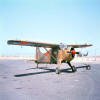
|
|
Beaver AL.1, XP819, parked on the pan at Khormaksar in the summer of 1967 (Richard Grevatte-Ball)
|
|
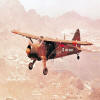
|
|
The same aircraft at low-level over Little Aden (Richard Grevatte-Ball)
|
|

|
|
A pair of 653 Sqn aircraft over Little Aden this time, DH Beaver AL.1, XP824, in formation with Westland Scout AH.1, XR628 (Richard Grevatte-Ball)
|
|
.jpg)
|
|
Although very little rain fell on Aden, it could be torrential when it did, forcing this 653 Sqn Beaver .....
|
|
.jpg)
|
|
..... to 'water ski' across the flooded Khormaksar pan (both, Richard Grevatte-Ball)
|
|
|
|
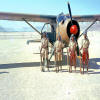
|
|
Local Arab Soldiers of the Federal Regular Army (FRA) guard Richard's aircraft on a remote airstrip in Area East (Richard Grevatte-Ball)
|
|
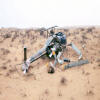
|
|
Scout, XR634, on its side after spinning twice while while trying to land. Luckily only one of the three crew were injured (Richard Grevatte-Ball)
|
|
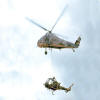
|
|
The damaged Scout is air-lifted back to base for repairs by an RAF Wessex, XS675 (Richard Grevatte-Ball)
|
|

|
|
Once in position the gun was soon in action. Note the discarded shell casing zipping passed the soldier's ear on the right (Richard Grevatte-Ball)
|
|
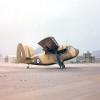
|
|
An usual visitor to Falaise Camp, 78 Sqn Twin Pioneer, XM286, taxies out for take-off back to Ksar (Richard Grevatte-Ball)
|
|
|
|
.jpg)
|
|
The loss of a Britannia was a rare occurrence but XL638-Sirius was written off after overshooting the Khormaksar runway ........
|
|
.jpg)
|
|
..... and into the sea after its reverse thrust failed to engage, 12-10-67 (both, Richard Grevatte-Ball)
For flight safety reasons, the fin was removed but the remainder of the hulk was left to its fate. |
|

|
|
653 Sqn departed from Aden in October 1967 and headed for Sharjah where this photo of Richard was taken alongside XP819 (Richard Grevatte-Ball)
|
|

|
|
Fully armed with two machine guns and 3" rockets, Omani Air Force Provost WV501's engine is run-up at Salalah in 1966 (Richard Grevatte-Ball)
It was about to undertake an attack on Communist infiltrators crossing from Saudi over the Oman border with the ‘Empty Quarter’. |
|
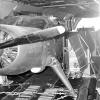
|
|
A Beaver being repatriated back to the UK in an RAF Hercules in 1967 (Richard Grevatte-Ball)
Note that the undercarriage legs had to be chained together and drawn in to enable the aircraft to be squeezed into the hold. |
|
|
Beaver 'bomber'
In the last few months leading up to the
1967 withdrawal from Aden, large areas of ‘up-country’ were declared by the
British Forces as ‘no go’ zones and any armed Arab could be ‘attacked’, even
before he had started firing first! I think that the powers-that-be had little
idea exactly how these last few months would pan out especially the level
of fighting that could be expected in the hinterland surrounding Aden town and
port, plus the few remaining up-country forts still manned by us. Part of this
worry was the fact that the RAF strike elements were also being severely reduced
as part of the drawdown process.
The upshot was that someone realised that
the AAC Beavers were all fitted with under wing Light Series Bomb Carriers (an
RAF issue item), which we used to carry parachute stores (5 jerry cans plus a
parachute - two of these under each wing. Plus every Beaver delivered to the AAC
had nose and tail bomb arming circuits! Always made me laugh! These parachute
stores (or bombs) were launched by arming the electrical circuit and then
pressing a button on the control yoke.
So these bomb carriers could be fitted with
25lb practice or fragmentation bombs. We trained, under RAF supervision and my
log book shows that I was signed-off as qualified to drop either type. Only snag
- we had no bombsight - so it was trial and error; chinagraph plus on the
Perspex window!”
The sequence below was taken by Richard at
Falaise Airfield (Little Aden) and
depict the preparation and execution of a training sortie in XP819.
|
|

|
|
653 Squadron Armourers attached the first bomb-round to the underwing rack.
|
|

|
|
When the pilots are ready to go, a third Armourer connects the electrics.
|
|

|
|
Bombed-up, revved-up and ready to go, XP819 is about to depart for a sortie on the (Khormaksar?) range.
|
|

|
|
Excellent timing as the photographer catches the stick of 25-pounders at the point of their release.
|
|
|
“Falaise
provide HQ and aircraft servicing facilities for the AAC and was the HQ of 24
Brigade, an armoured car regiment and an infantry battalion.
Luckily we were NEVER called upon to attack
in anger and to my certain knowledge AAC Beavers never adopted this role
anywhere else throughout the Beaver’s time with the British Army. So I am one of
just seven army pilots with this qualification in my logbook!! The photos depict
practice bombs being ‘hooked up’ and dropped on the range.
The Beavers withdrawal from Aden
The Aden campaign
was in its closing stages; all British troops had been withdrawn from the
interior to the supposedly secure base surrounding the town of Aden and its
port. The Army Air Corps element was rapidly dwindling, 8 Flight with their
Scout helicopters had returned to
England,
leaving the remaining Scouts of 13 Flight to prepare for a move to Sharjah
in the Arabian Gulf. No. 15
Flight were endeavouring to coax four of their Beaver aircraft into Belfast
transports of the RAF for the move back to the UK whilst the final three were
the only remaining aircraft, together with Beverleys of the RAF, to continue
flying up country, in support of the rapidly mutinying South Arabian
Army. Each trip was full of doubt, which side would the Arab troops stationed in
the particular part to be visited be on; the Adenese Government, the National
Liberation Front, or the Front for the Liberation of Occupied South Yemen.
At last,
on 13 October 1967, the day
arrived when the Beavers were finally to leave Aden. Loyalties had been
exchanged from 15 Flight with their ‘witch on a broomstick’ to 13 Flight and
their ‘black cats’. Of 13 Flight’s six Scouts only one was able to fly a
farewell salute, and this aircraft was cleared for only the flights on to and
off HMS Fearless, having a suspect main rotor gearbox. The three Beavers,
all fully serviceable, were fitted with long range ferry tanks, the last
aircraft completed its final up country detail on the evening before departure,
and with a somewhat bloated take off, full of ‘free’ gifts from the RAF quarters
at Khormaksar—were away, to Sharjah.
The trip was
planned to take three days, following the Arabian Peninsular coast line via the
RAF staging airfields of Salalah, Masirah and the Sultan of Muscat and
Oman’s airfield
at Bait. Climbing to 8,000 feet, Salalah was six and a half hours flying away,
with a ferry tank range of nine hours, and all went well till about four hours
out, one of the aircraft, flown by Lt Nigel Ironside,
AAC, developed a total propeller oil seal failure. The results of this
are always alarming, little engine control is left and the windscreen gets
coated with oil; so too did the pilot on this occasion, as his side window was
open! It was impossible to fly to Salalah, or return to
Aden, so a precautionary landing was
made at the only known airstrip in the area, Riyan. This had once belonged to
the RAF, but was now known to be in the hand of local Arab Forces.
The third Beaver, flown by Sgt J. Cant, REME, remained
circling overhead whilst the other two aircraft landed, to be greeted by

 a motley selection of Arabs dressed in assorted uniforms
with red stars on peaked baseball caps, and Russian-style Chinese manufactured
automatic weapons. Not being locked up
straight away, it was decided to change the propeller seal and endeavour to
bluff our way through. Sgt Cant’s
aircraft therefore touched down well out of
harms way at the edge of the airfield to land our chief mechanic, Sgt Jupp,
REME. Quickly airborne he left Staff some considerable distance to walk to our
location, and when finally a very hot mechanic arrived, this last aircraft was
well on its way to Aden for assistance.
a motley selection of Arabs dressed in assorted uniforms
with red stars on peaked baseball caps, and Russian-style Chinese manufactured
automatic weapons. Not being locked up
straight away, it was decided to change the propeller seal and endeavour to
bluff our way through. Sgt Cant’s
aircraft therefore touched down well out of
harms way at the edge of the airfield to land our chief mechanic, Sgt Jupp,
REME. Quickly airborne he left Staff some considerable distance to walk to our
location, and when finally a very hot mechanic arrived, this last aircraft was
well on its way to Aden for assistance.
Whilst working on the engine we were guarded by a group of
Arabs, although this did not stop another group from shooting in our direction
on two occasions! We were interested to see a hi-jacked Air Djibouti DC.3 parked
on the pan, which the only English-speaking Arab said was being used for gun
running. This aircraft had been captured whilst on a routine charter flight from
French Somaliland; and when after a successful ground run our English-speaking
Arab asked us to remain till ‘someone comes from the local town to speak with
you’, we had visions of our being in the gun running business also!
By now, if not allowed to depart
soon, we would not be able to make Salalah before nightfall, and the position
seemed to be stalemate. However, a check call on the UHF radio produced the, oh,
so welcome voice of an RAF Hunter pilot, “overhead at 35,000 feet and don’t
want to come down as it will use up my fuel and anyway might precipitate some
adverse action.”
Alas this incident not specifically mentioned in the RAF Operational Records -
but it was very close to everyone’s departure from Aden.
However, the Arabs had seen us
talking by radio—obviously we had help at hand, and this seemed to do the trick.
A complete reversal of attitude ensued, “we are your friends,” they said, “you
can go.” Without so much as an engine check, not even a doing up of straps, we
were off, showering them
in as much sand as possible, and we reached RAF
Salalah just after dark.
Our troubles were not yet over,
however, is a somewhat belated after flight inspection the next morning on the
two aircraft revealed that the one flown by Nigel Ironside had in fact been hit,
we presumed whilst on the ground at Riyan. A bullet had gone through
the port tail plane and elevator
torque tube and the aircraft was judged to be unsafe for further flying, so a
week’s wait in the very pleasant atmosphere of Salalah was required whilst
spares were flown out by the RAF. Even so the two Beavers still made RAF
Sharjah, our new home, before the helicopters in HMS Fearless. We flew
over the ship whilst it was at anchor off the Muscat coast, with no sign of life
on board, everybody recovering below from the party of the night before!
And the third
Beaver, we had hoped would have been able to fly once again from Aden to re-join
us at Salalah, but the Staff thought otherwise. It was de-winged and flown up to
Sharjah in the belly of a Hercules, and so put off by this flight that it was
eight weeks before it would fly again with the various faults that it acquired.
And the final note, we were accused by the Staff in
Aden of jeopardizing the Anglo-South
Arabian talks, then going on in Switzerland, by trying to start a war at Riyan.




.jpg)
.jpg)





.jpg)

.jpg)






